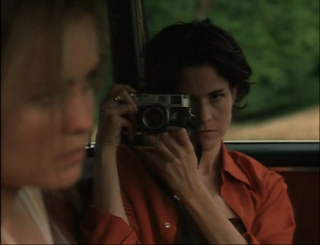High Art (1998)
Dir: Lisa Cholodenko
Setting: A kitchen in a retro-esque cabin. A woman, who had previously been with a man, is sitting on the counter. She is dressed in shorter shorts, with a retro-esque wifebeater. Another woman in a black wifebeater and a red button up comes up with thick-crystal goblets, and pours glasses of red wine. They take two sips and then head off the bedroom. The whole image looks like a faded, almost distressed, Poloroid.
In one scene, Lisa Cholodenko has almost captured the hipster milieu through the attempt to capture the imagery of Nan Goldin. In fact, all of High Art is almost a call to arms for a new culture of fetishizing the authentic and the retro. The main character of High Art is a photographer who specializes in almost portraiture that captures an intimacy with a faded theme. She has retired from the photography scene for a decade. Her girlfriend is a faded German actress who used to work for Fassbinder. They live in a large New York loft with junky plumbing, and surrounded by faded antique or retro furniture.
The secondary character is a young girl who just got promoted to be the assistant editor of Frame Magazine. She lives in a boring apartment with a boring boyfriend, until she starts dating the photographer. She starts fetishizing the photography, and coveting the authentic artist lifestyle even as she doesn't want to let herself go.
It is in the lesbian/heroin movie High Art that the modern hipster has found their Brooks Brothers Catalog. No, more than that. They found their guide to living. Their raison d'etre. High Art is about the inauthentic fetishization of the authentic, and such is the siren call of the hipster. The only thing missing is the irony...which only happens mildly in the final scene, which makes a tragic joke out of the whole story.
The whole movie is about one woman who is catering to her lesbian side because it has been sparked by this exotic artist who is living the way that she wants to live. The exotic artist leaves for awhile to sober up because she knows that the heroin chic has been costing her her ambition. The editor finally comes to terms with exposing herself in an attempt to live authentically. And, finally, they're going to live together when...BAM, the artist ODs.
The finale was supposed to be a tragic consequence of heroin, but it really isn't. It reads more like a final ironic twist that a young girl is ultimately unable to achieve authenticity by sleeping with an authentic person. For all we know, the photographer ran away with her girlfriend and had somebody tell the editor she was dead (which would be AMAZING). And, it really solidifies my reading that the editor was simply dyking out in an attempt to be cool, as so many Katy Perry's would do before they would go back to their boyfriends.
On the other hand, the authentic ending lesbian relationship of the German and the photographer is AMAZING. They fight bitterly, and frequently as they have come to see each other as the thing they hate about themselves. They start blaming each other for their life's mistakes, and that reads as real. Miserable, but real. And, it's that miserableness that no hipster really ever wanted to emulate. They wanted the highs and lows, and the search for the authentic, and thus it was better to emulate the editor who would succeed because of her ability to sleep with success.
If you haven't seen High Art in awhile, and I haven't heard it talked about all that much, it feels like a deep track now. It's sort of like unearthing that proto-Kraftwerk album, or the punk before there was punk. High Art even used the term hipster before hipster was really a cultural thing, when the editor's boyfriend grouses about the editor's "hipster friends." And, as such, it is highly recommended.


No comments:
Post a Comment